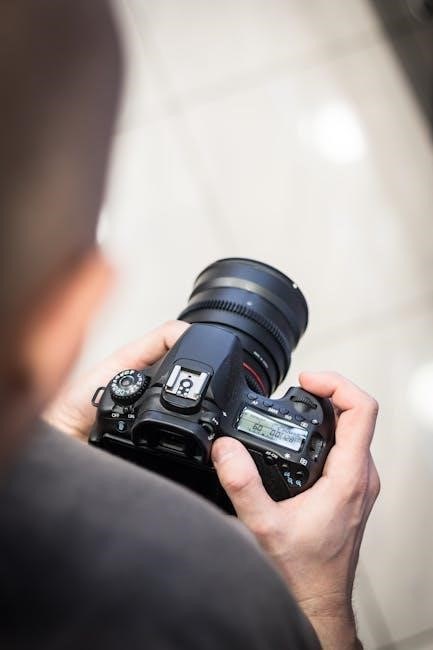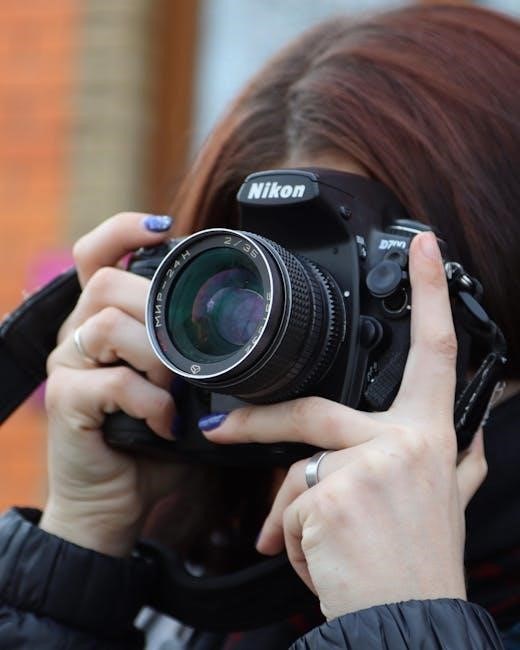The Nikon D5500 is a versatile DSLR camera designed for enthusiast photographers‚ offering a 24.2MP APS-C sensor‚ EXPEED 4 processor‚ and vari-angle touchscreen LCD. Its lightweight build‚ advanced autofocus‚ and built-in Wi-Fi make it ideal for capturing high-quality images and videos. This guide helps users master its features‚ ensuring optimal performance in various shooting scenarios.
Overview of the Camera and Its Key Features
The Nikon D5500 features a 24.2MP APS-C sensor‚ EXPEED 4 image processor‚ and a vari-angle 3.0-inch touchscreen LCD. It supports Full HD video recording‚ built-in Wi-Fi‚ and NFC for seamless connectivity. The camera offers 11 autofocus points‚ ISO sensitivity up to 25600‚ and a burst mode of 5fps. Its lightweight design and intuitive controls make it ideal for capturing sharp images in various lighting conditions‚ catering to both enthusiasts and professionals.
Importance of the User Manual for Optimal Camera Use
The Nikon D5500 user manual is essential for unlocking the camera’s full potential. It provides detailed guidance on operating advanced features‚ customizing settings‚ and troubleshooting common issues. By understanding the manual‚ users can master techniques‚ optimize image quality‚ and explore creative possibilities‚ ensuring they get the most out of their photography experience with the D5500.

Camera Design and Ergonomics
The Nikon D5500 features a lightweight‚ ergonomic design with a vari-angle touchscreen LCD‚ ensuring comfort and intuitive control access. Its compact build enhances portability while maintaining durability.
Body Layout and Button Configuration
The Nikon D5500 features an intuitive control layout‚ with buttons strategically placed for easy access. The vari-angle touchscreen LCD enhances usability‚ while the mode dial and live view selector simplify switching between modes; Ergonomic design ensures comfort during extended use‚ with key controls like the multi-selector and command dials positioned for quick adjustments‚ optimizing both functionality and user experience.
Display Options: LCD Screen and Viewfinder
The Nikon D5500 features a 3-inch vari-angle LCD touchscreen‚ enabling flexible shooting from various angles. The optical viewfinder provides a clear‚ real-time preview for precise composition. The touchscreen allows for intuitive focus selection and shooting‚ while the viewfinder offers a traditional shooting experience‚ catering to both modern and classic preferences for enhanced versatility and user satisfaction.
Weight and Build Quality
The Nikon D5500 is lightweight‚ weighing approximately 470g‚ making it portable for extended shoots. Its durable carbon fiber-reinforced polymer body offers a solid feel without compromising on comfort or stability. The ergonomic design ensures a comfortable grip‚ while the weather-sealed buttons and controls provide reliable operation under various conditions‚ balancing durability and portability for photographers seeking a reliable DSLR experience.
Setting Up the Camera
Initial setup involves inserting the battery and memory card‚ mounting the lens‚ and navigating the menu system for customizing settings to suit your photography needs.
Inserting the Battery and Memory Card
Insert the EN-EL14a battery into the camera grip‚ ensuring it clicks securely. Next‚ open the memory card slot on the side‚ insert a compatible SD‚ SDHC‚ or SDXC card with the label facing the camera‚ and close the slot. Ensure the battery is fully charged before use for optimal performance and to avoid interruption during shooting sessions.
Mounting the Lens and Basic Camera Setup
To mount the lens‚ align the F-mount on the camera with the lens contacts‚ then twist gently until it clicks. Turn on the camera‚ set the language‚ date‚ and time. Ensure the battery is fully charged and insert a memory card. Familiarize yourself with the mode dial‚ adjusting settings as needed for your first shoot. Always use a fully charged battery and compatible SD card for optimal performance.
Navigating the Menu System
Access the menu by pressing the menu button‚ then use the multi-selector to navigate through options. The camera menu is divided into tabs‚ including Shooting‚ Setup‚ Retouch‚ and My Menu. Use the multi-selector to scroll and the OK button to select items. Customize settings like image quality‚ white balance‚ and autofocus modes. The My Menu tab allows you to save frequently used settings for quick access.
Shooting Modes and Techniques
The Nikon D5500 offers various shooting modes‚ including Auto‚ Manual‚ and Scene modes‚ allowing photographers to capture images in diverse conditions. These modes enhance creativity and adaptability‚ enabling users to achieve optimal results in different scenarios.
Understanding Auto‚ Manual‚ and Scene Modes
The Nikon D5500 offers Auto‚ Manual‚ and Scene modes to cater to different photography needs. Auto mode simplifies shooting‚ while Manual mode provides full control over settings. Scene modes optimize camera settings for specific scenarios like portraits‚ landscapes‚ and night photography‚ ensuring users can easily adapt to various conditions and capture high-quality images effectively.
Customizing Settings for Different Shooting Scenarios
The Nikon D5500 allows users to tailor settings to specific shooting conditions. Picture Controls enable adjustments for color‚ contrast‚ and sharpness‚ while White Balance ensures accurate color rendition. Customizing autofocus modes and metering options enhances focus and exposure control. These features empower photographers to adapt quickly to diverse scenarios‚ from portraits to action shots‚ ensuring optimal results in any situation.

Focusing and Metering
The Nikon D5500’s focusing and metering systems are essential for capturing sharp images. Featuring a 39-point autofocus system and 2016-pixel metering sensor‚ it ensures precise focus and accurate exposure control.
Autofocus Modes and Manual Focus Techniques
The Nikon D5500 offers various autofocus modes‚ including Single AF‚ Continuous AF‚ and Manual Focus. Single AF is ideal for stationary subjects‚ while Continuous AF tracks moving subjects. Manual Focus allows precise control for creative shots. The camera also supports AF-P lenses with stepping motors for smooth and quiet focusing‚ enhancing video recording and still photography experiences.
Understanding Metering Modes and Exposure Control
The Nikon D5500 offers three metering modes: Matrix‚ Center-Weighted‚ and Spot. Matrix metering balances exposure across the frame‚ while Center-Weighted prioritizes the central area. Spot metering measures light from a specific spot for precise control. Exposure compensation‚ Active D-Lighting‚ and bracketing tools are also available to refine results in challenging lighting conditions‚ ensuring optimal image brightness and detail retention.

Video Recording Capabilities
Records 1080p video at 60fps‚ featuring vari-angle LCD for flexible framing. Built-in stereo mic and external microphone support enhance audio. Manual exposure control ensures creative filming.
Resolution Options and Frame Rates
The Nikon D5500 offers multiple resolution settings for video recording‚ including 1920×1080‚ 1280×720‚ and 640×424 pixels. Frame rates vary from 24p to 60p‚ allowing users to choose between cinematic or smoother motion. These options provide flexibility for different shooting styles‚ ensuring high-quality video output tailored to specific creative or practical needs.
Using Stabilization and Audio Settings
The Nikon D5500 features Vibration Reduction (VR) in select lenses to minimize camera shake during handheld shooting. For audio‚ the built-in microphone allows adjustment of sensitivity levels‚ and wind noise reduction can be enabled. Additionally‚ the camera supports external microphone input for higher-quality sound recording‚ enhancing video production capabilities with improved stability and audio control.
Image Quality and Customization
The Nikon D5500 offers exceptional image quality with customizable settings. Users can adjust white balance‚ Picture Controls‚ and choose between JPEG and RAW formats for enhanced flexibility in post-processing.
Adjusting Image Settings: JPEG vs. RAW
The Nikon D5500 allows users to choose between JPEG and RAW file formats. JPEG offers smaller file sizes and instant sharing‚ while RAW captures more image data for advanced editing. Understanding these formats helps photographers tailor their workflow to suit their needs‚ whether prioritizing convenience or creative control.
Customizing White Balance and Picture Controls
The Nikon D5500 allows precise control over white balance‚ ensuring accurate color representation in various lighting conditions. Users can choose from presets like Auto‚ Daylight‚ or Fluorescent‚ or set a custom Kelvin value. Picture Controls offer flexibility in adjusting contrast‚ saturation‚ and sharpness‚ enabling photographers to tailor images to their creative vision‚ with options like Standard‚ Neutral‚ and Vivid profiles;
Memory Cards and File Formats
The Nikon D5500 supports SD‚ SDHC‚ and SDXC memory cards‚ enabling storage of NEF (RAW)‚ JPEG‚ and MOV files for versatile image and video capture.
Choosing the Right Memory Card
For the Nikon D5500‚ select SD‚ SDHC‚ or SDXC cards with UHS-I compatibility for optimal performance. Use cards with sufficient storage capacity based on your needs. Ensure the card is formatted in the camera for proper functionality. Avoid using multiple cards interchangeably without formatting to prevent data corruption. Always check the card’s write speed for smooth burst mode and video recording.
Understanding File Formats: NEF‚ JPEG‚ and MOV
The Nikon D5500 supports three primary file formats: NEF (Nikon’s raw format)‚ JPEG (compressed)‚ and MOV (video). NEF captures maximum image data for post-processing flexibility. JPEG offers smaller file sizes for sharing. MOV records video in H.264 format. Use NEF for professional editing‚ JPEG for convenience‚ and MOV for high-quality video. Properly organize these files for efficient workflow management.

Camera Maintenance and Firmware Updates
Regularly clean the camera sensor and exterior to prevent dust buildup. Update firmware for improved performance‚ new features‚ and bug fixes. Ensure optimal functionality and longevity.
Cleaning the Camera and Sensor
Regularly clean the camera exterior with a soft‚ dry cloth to remove dust and smudges. For the sensor‚ use a blower or manual cleaning mode. Avoid harsh chemicals. Gently wipe the lens with a microfiber cloth. For stubborn spots‚ use a cleaning solution and swabs. Clean the viewfinder with a soft brush or cloth. Ensure all parts are dry to prevent damage. Clean the sensor only when necessary‚ using Nikon-approved tools. If unsure‚ consult a professional.
Updating Firmware for Enhanced Performance
Updating the Nikon D5500’s firmware ensures optimal performance‚ adding new features and fixing issues. Check for updates on Nikon’s official website or via the Nikon Manual Viewer 2 app. Download the latest version‚ then follow the on-screen instructions to install. Ensure the camera is fully charged and avoid interruptions during the update process to prevent potential damage or malfunctions. Regular updates are crucial for maintaining peak functionality and compatibility with new lenses or accessories. Always verify the firmware version matches your camera model to avoid errors. Updating firmware can enhance autofocus accuracy‚ improve video recording capabilities‚ and expand compatibility with the latest NIKKOR lenses. If unsure‚ refer to the user manual or contact Nikon support for assistance. Keep your camera up-to-date for the best shooting experience. If issues arise‚ reset the camera or consult a professional. Firmware updates are essential for maximizing your camera’s potential and ensuring smooth operation across all modes. Always backup settings before updating‚ as some configurations may reset. Stay updated to benefit from Nikon’s continuous improvements and enhancements. Updating firmware is a simple process that significantly impacts performance and functionality. Regular checks ensure you have the latest features and fixes for uninterrupted photography. Nikon periodically releases firmware updates to address user feedback and improve overall camera performance. By keeping your D5500 updated‚ you ensure compatibility with the latest accessories and maintain its cutting-edge capabilities. Firmware updates are a key part of camera maintenance and should be done regularly to optimize your photography experience. Nikon’s firmware updates often include improvements for autofocus‚ metering‚ and video recording‚ making them essential for professional and enthusiast photographers alike. Always prioritize firmware updates to unlock your camera’s full potential. Updating firmware is a straightforward process that can be done at home‚ but it requires careful attention to instructions to avoid complications. Nikon provides detailed guidance in the user manual or through their support channels to help users update their firmware safely. If you encounter any issues during the update‚ power off the camera‚ wait‚ and restart the process. Never interrupt the update process‚ as this could render the camera inoperable. If problems persist‚ contact Nikon support for assistance. Firmware updates are a critical aspect of camera maintenance‚ ensuring your Nikon D5500 operates at its best. Regularly check for updates to take advantage of new features and improvements. Nikon’s firmware updates are designed to enhance your photography experience‚ so keep your camera updated for optimal results. Updating firmware is a simple yet important step in maintaining your camera’s performance and functionality. Always follow Nikon’s guidelines to ensure a smooth and successful update process. By staying updated‚ you can enjoy the latest advancements in technology and photography capabilities with your Nikon D5500.
Mastering the Nikon D5500 requires practice and understanding its features. Use this guide to optimize your photography skills and explore additional resources for further learning and improvement.
Final Tips for Mastering the Nikon D5500
Experiment with manual modes to refine your skills. Regularly update firmware for optimal performance. Use the Nikon Manual Viewer 2 app for quick reference. Practice with different lenses and settings to enhance your photography. Explore additional resources like David Busch’s guide for advanced techniques. Clean your camera regularly to maintain image quality. Keep experimenting to unlock the D5500’s full potential.
Additional Resources for Further Learning
Explore David Busch’s Compact Field Guide for in-depth techniques. Visit Nikon’s official website for downloadable manuals and software. Utilize the Nikon Manual Viewer 2 app for mobile access. Check out tutorials on YouTube‚ like the DSLR GUIDE FOR BEGINNER. Refer to technical specifications and user reviews for enhanced understanding. These resources will help you maximize your Nikon D5500 experience.